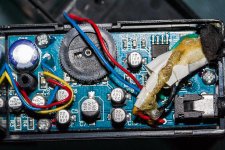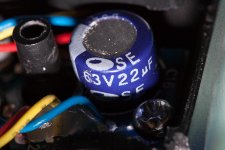Hello,
I am a DSLR video shooter who recently got an iRig Pre which is a small, inexpensive, 9v battery powered microphone preamplifier. It offers decent quality audio when paired with a high sensitivity microphone such as the Audio Technica AT875R.
Lately I've been reading about upgrading components such as opamps and capacitors and I was wondering if it would be possible to improve the sound of the iRig Pre by lowering the noise floor. The opamp in it is a RC4580i which from what I can understand is similar to the much discussed NE5532. Now if it is better or worse, I was hoping someone could tell me as I cant find any opinions on it. It also has plenty of capacitors which are of a Chinese brand called RVT, I suppose they aren't good?
Anyway, I'll attach 2 images of the pcb and I would be really grateful if someone be kind enough to share their expertise 🙂
I am a DSLR video shooter who recently got an iRig Pre which is a small, inexpensive, 9v battery powered microphone preamplifier. It offers decent quality audio when paired with a high sensitivity microphone such as the Audio Technica AT875R.
Lately I've been reading about upgrading components such as opamps and capacitors and I was wondering if it would be possible to improve the sound of the iRig Pre by lowering the noise floor. The opamp in it is a RC4580i which from what I can understand is similar to the much discussed NE5532. Now if it is better or worse, I was hoping someone could tell me as I cant find any opinions on it. It also has plenty of capacitors which are of a Chinese brand called RVT, I suppose they aren't good?
Anyway, I'll attach 2 images of the pcb and I would be really grateful if someone be kind enough to share their expertise 🙂
Attachments
Welcome to diyAudio 🙂
That's a tough one to answer... I suspect the design of the preamp itself could be a limiting factor and that swapping just the opamp for say a 5532 might not give the improvement you seek. The 4580 is pretty decent and works well at low supply voltages, which is a consideration. It also draws less current than the 5532. Also powered mics with their inbuilt FET preamp generate noise up front too.
True low noise design for mic preamps is similar in may ways to high quality phono stages... its a specialised skill requiring absolute optimum use of devices, and is often discrete rather than opamp based for the front end stage.
The caps may not be the most desirable brand but I'm sure they are perfectly serviceable and they won't alter anything by being replaced.
That is all just my opinion though 🙂 See what others think......
That's a tough one to answer... I suspect the design of the preamp itself could be a limiting factor and that swapping just the opamp for say a 5532 might not give the improvement you seek. The 4580 is pretty decent and works well at low supply voltages, which is a consideration. It also draws less current than the 5532. Also powered mics with their inbuilt FET preamp generate noise up front too.
True low noise design for mic preamps is similar in may ways to high quality phono stages... its a specialised skill requiring absolute optimum use of devices, and is often discrete rather than opamp based for the front end stage.
The caps may not be the most desirable brand but I'm sure they are perfectly serviceable and they won't alter anything by being replaced.
That is all just my opinion though 🙂 See what others think......
Hello Mooly and thank you very much for your input,
I'm kinda glad to know the opamp is of good quality but at the same time a little bummed to know there is not room for improvement...
I'm kinda glad to know the opamp is of good quality but at the same time a little bummed to know there is not room for improvement...
- Status
- Not open for further replies.

